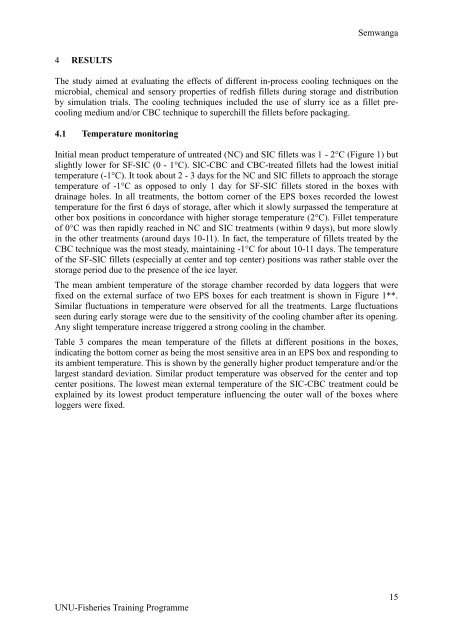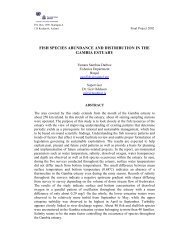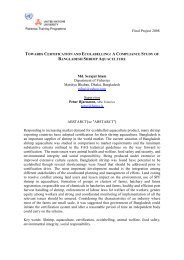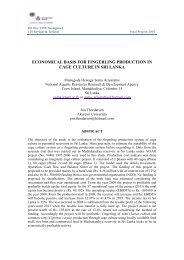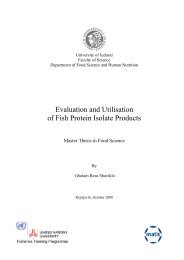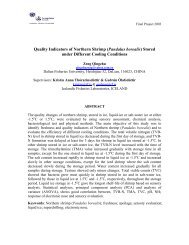THE EFFECT OF DIFFERENT COOLING TECHNIQUES ON THE ...
THE EFFECT OF DIFFERENT COOLING TECHNIQUES ON THE ...
THE EFFECT OF DIFFERENT COOLING TECHNIQUES ON THE ...
Create successful ePaper yourself
Turn your PDF publications into a flip-book with our unique Google optimized e-Paper software.
Semwanga4RESULTSThe study aimed at evaluating the effects of different in-process cooling techniques on themicrobial, chemical and sensory properties of redfish fillets during storage and distributionby simulation trials. The cooling techniques included the use of slurry ice as a fillet precoolingmedium and/or CBC technique to superchill the fillets before packaging.4.1 Temperature monitoringInitial mean product temperature of untreated (NC) and SIC fillets was 1 - 2°C (Figure 1) butslightly lower for SF-SIC (0 - 1°C). SIC-CBC and CBC-treated fillets had the lowest initialtemperature (-1°C). It took about 2 - 3 days for the NC and SIC fillets to approach the storagetemperature of -1°C as opposed to only 1 day for SF-SIC fillets stored in the boxes withdrainage holes. In all treatments, the bottom corner of the EPS boxes recorded the lowesttemperature for the first 6 days of storage, after which it slowly surpassed the temperature atother box positions in concordance with higher storage temperature (2°C). Fillet temperatureof 0°C was then rapidly reached in NC and SIC treatments (within 9 days), but more slowlyin the other treatments (around days 10-11). In fact, the temperature of fillets treated by theCBC technique was the most steady, maintaining -1°C for about 10-11 days. The temperatureof the SF-SIC fillets (especially at center and top center) positions was rather stable over thestorage period due to the presence of the ice layer.The mean ambient temperature of the storage chamber recorded by data loggers that werefixed on the external surface of two EPS boxes for each treatment is shown in Figure 1**.Similar fluctuations in temperature were observed for all the treatments. Large fluctuationsseen during early storage were due to the sensitivity of the cooling chamber after its opening.Any slight temperature increase triggered a strong cooling in the chamber.Table 3 compares the mean temperature of the fillets at different positions in the boxes,indicating the bottom corner as being the most sensitive area in an EPS box and responding toits ambient temperature. This is shown by the generally higher product temperature and/or thelargest standard deviation. Similar product temperature was observed for the center and topcenter positions. The lowest mean external temperature of the SIC-CBC treatment could beexplained by its lowest product temperature influencing the outer wall of the boxes whereloggers were fixed.UNU-Fisheries Training Programme15


